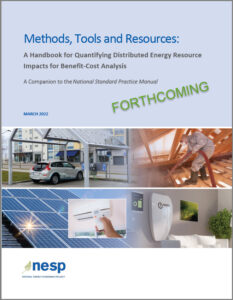What’s in Store for 2022?
(Continued from NESP Quarterly February 14, 2022) — This year is off to a busy start! New publications are coming soon, we are providing technical assistance to states applying the NSPM, and we’re gearing up to expand the NSPM to address key topics including guidance on accounting for energy equity.
Companion Resources to the NSPM
In our October NESP Quarterly (pg. 6), we shared a flavor of two forthcoming NESP publications:

- Methods, Tools & Resources: A Handbook for Quantifying Distributed Energy Resource Impacts for Benefit-Cost Analysis; and
- Benefit-Cost Analysis Case Studies – Examples of Distributed Energy Resource Use Cases
While we hoped to publish by now, they are expected in March 2022. These companion documents to the NSPM for DERs will further help guide jurisdictions in their BCA efforts.
The 200+ page Methods, Tools & Resources (a.k.a. “MTR Handbook”) provides a wealth of technical information on how to quantify the full range of utility system and non-utility system impacts of DER investments, with links to resources and tools. Once a jurisdiction applies the NSPM BCA framework to develop or update its primary cost-effectiveness test, the MTR Handbook can guide decisions on what methods to use to quantify the relevant impacts in the jurisdiction’s BCA test.
The BCA Case Studies take the theoretical to application. Informed by real-world use cases but generalized into illustrative examples, they demonstrate applying the NSPM to specific DER technologies and programs of growing interest: residential EV managed charging, commercial combined solar and storage dispatch, and residential grid-interactive and efficient building (GEB) retrofits. The three case studies highlight different jurisdiction-specific tests (JSTs) based on policy objectives for three hypothetical jurisdictions. Each illustrates key BCA considerations for either single or multi-DER use cases and demonstrates different approaches to account for impacts when certain data may be unavailable.
State Technical Assistance in Applying the NSPM
We are providing technical assistance to commissions in applying the NSPM framework. Assistance is in the context of updating BCA practices for DER programs, procurement, and/or broader planning efforts. With support from U.S. DOE via Lawrence Berkeley National Laboratory, we will provide technical assistance throughout the year to select states, budget permitting. If your jurisdiction is interested in such services, please contact NSPM@nationalenergyscreeningproject.org.
Expanding NSPM Guidance
Based on 2021 experience with NSPM application, we are prioritizing areas where additional guidance is warranted to help jurisdictions with BCA practices, such as:
- Accounting for energy equity in the context of benefit-cost analyses (BCAs), including developing the concept of a separate but complementary distributional equity analysis.
- Applying the principles and concepts of the NSPM to a range of regulatory settings, including distribution system planning, integrated resource planning, grid modernization, time-of-use rates, and more.
- Use of discount rates in BCAs, including whether and how to use different rates for different BCA tests and across BCA assumptions (e.g., for the social cost of carbon versus other costs or benefits), and use of nominal vs real rates, etc.
- How to treat offsetting impacts (i.e., transfer payments), especially in context of tax incentives.
- Treatment of other fuel impacts to consider in BCA, which is particularly relevant and important for electrification measures, programs and strategies.
These updates/expansions to the NSPM are slated for later 2022.
See the entire February 2022 NESP Quarterly.

